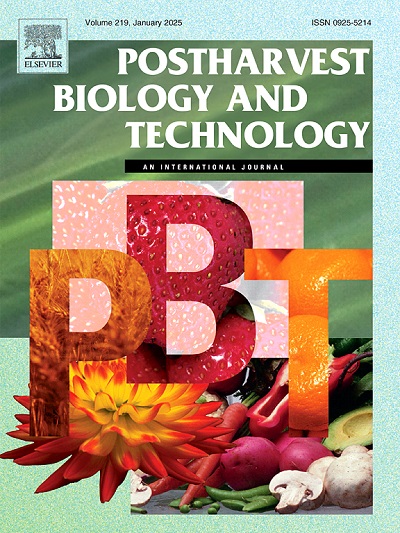Differential low oxygen response and transcriptomic shifts drive fresh-cut lettuce deterioration in modified atmosphere packaging
IF 6.4
1区 农林科学
Q1 AGRONOMY
引用次数: 0
Abstract
Fresh-cut lettuce (Lactuca sativa) requires modified atmosphere packaging (MAP) with low oxygen (< 3 % O₂) to prevent enzymatic discoloration. However, some accessions exhibit rapid deterioration under these low oxygen conditions, resulting in significant product loss. This study investigated the mechanisms of this heritable deterioration, linked to the qSL4 locus, by examining respiration and transcriptomic responses. We found that rapid deterioration is associated with continued, albeit reduced, respiration under very low oxygen levels (<1 % O₂), with minimal effects from CO₂ and ethylene. Deterioration differences lessened at higher O₂ levels (∼20 %), emphasizing oxygen's critical role. RNA-seq analysis of slow (Salinas 88) and rapid (La Brillante) deteriorating cultivars revealed distinct early transcriptomic shifts under MAP. La Brillante upregulated more genes (1837) and downregulated fewer (1735) than Salinas 88 (1185 upregulated, 2367 downregulated), indicating higher metabolic activity in rapid deteriorating cultivar. Notably, glycolysis and electron transport chain (ETC) genes showed differential expression; ATP-consuming enzymes (fructokinase, hexokinase) and ETC complexes I and IV were upregulated in La Brillante but downregulated in Salinas 88. Conversely, Salinas 88 exhibited higher expression of alternative oxidase (AOX) genes, suggesting ATP conservation and reduced oxygen use. These findings indicate that slow-deteriorating genotypes maintain quality under low oxygen by limiting sugar and ATP consumption, while rapid deteriorating genotypes sustain higher metabolic activity, accelerating deterioration and likely shifting towards fermentation. This study provides insight into the early stages of lettuce deterioration and highlight the importance of low oxygen tolerance and metabolic adjustment capacity, setting the stage for future genomic research and functional studies on postharvest respiration and fermentation.
不同的低氧反应和转录组变化驱动鲜切生菜在改良空气包装中的变质
鲜切莴苣(lacuca sativa)需要低氧(<;3 % O₂),以防止酶变色。然而,在这些低氧条件下,一些添加物表现出快速变质,导致重大的产品损失。本研究通过检测呼吸和转录组反应,研究了与qSL4位点相关的这种遗传性退化的机制。我们发现,在非常低的氧气水平(<1 % O₂)下,快速恶化与持续(尽管减少)呼吸有关,CO₂和乙烯的影响最小。在较高的O₂水平(~ 20 %)下,退化差异减小,强调了氧气的关键作用。对慢变质品种(Salinas 88)和快变质品种(La Brillante)的RNA-seq分析显示,MAP作用下的早期转录组发生了明显的变化。与Salinas 88(上调1185个,下调2367个)相比,La Brillante基因上调较多(1837个),下调较少(1735个),表明快速退化品种的代谢活性更高。值得注意的是,糖酵解和电子传递链(ETC)基因表现出差异表达;atp消耗酶(果糖激酶、己糖激酶)和ETC复合物I和IV在La Brillante中上调,而在Salinas 88中下调。相反,Salinas 88表现出更高的替代氧化酶(AOX)基因表达,表明ATP保存和氧气消耗减少。这些发现表明,缓慢降解的基因型在低氧条件下通过限制糖和ATP的消耗来维持品质,而快速降解的基因型维持较高的代谢活性,加速降解并可能转向发酵。该研究揭示了生菜变质的早期阶段,强调了低氧耐受性和代谢调节能力的重要性,为未来的基因组研究和采后呼吸和发酵的功能研究奠定了基础。
本文章由计算机程序翻译,如有差异,请以英文原文为准。
求助全文
约1分钟内获得全文
求助全文
来源期刊

Postharvest Biology and Technology
农林科学-农艺学
CiteScore
12.00
自引率
11.40%
发文量
309
审稿时长
38 days
期刊介绍:
The journal is devoted exclusively to the publication of original papers, review articles and frontiers articles on biological and technological postharvest research. This includes the areas of postharvest storage, treatments and underpinning mechanisms, quality evaluation, packaging, handling and distribution of fresh horticultural crops including fruit, vegetables, flowers and nuts, but excluding grains, seeds and forages.
Papers reporting novel insights from fundamental and interdisciplinary research will be particularly encouraged. These disciplines include systems biology, bioinformatics, entomology, plant physiology, plant pathology, (bio)chemistry, engineering, modelling, and technologies for nondestructive testing.
Manuscripts on fresh food crops that will be further processed after postharvest storage, or on food processes beyond refrigeration, packaging and minimal processing will not be considered.
 求助内容:
求助内容: 应助结果提醒方式:
应助结果提醒方式:


